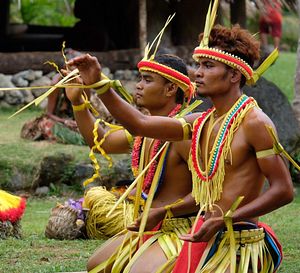On the tiny Pacific island of Yap, when it was time for a girl to become a woman, she would traditionally go to a special house in the forest for four months. While there, she was forbidden from seeing men or most others from her village and followed a strict regime of preparation for adulthood. She could not touch her body and wore clothing of woven pandanus leaves. Old women would shower her, treat her skin with coconut oil, and teach her how to take care of herself.
At the end of the four months, she would venture out into a sometimes frightening and brutal world, in which it was not uncommon for strangers from another village to be killed for trespassing. It was virtually impossible for such a woman to meet and to form a relationship with someone from outside her caste, her village, and her destiny.
To make her way peacefully in the outside world, the young woman would, by convention, break off a twig from a particular tree and carry it with her as she headed home to enter society as an adult. The twig indicated to all who observed that she walked with peaceful intentions and offered respect to the traditional owners of the land through which she passed.
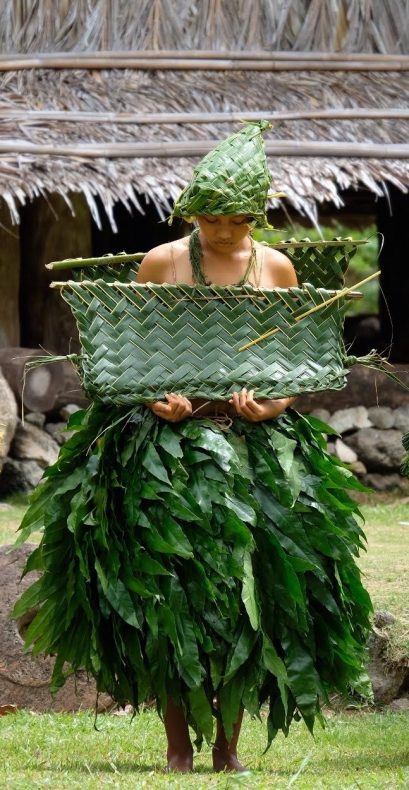 In the traditional societies of Micronesia, customs hold strong. Even today, travelers in Yap carry a twig or a basket, as a message of respect as they walk.
In the traditional societies of Micronesia, customs hold strong. Even today, travelers in Yap carry a twig or a basket, as a message of respect as they walk.
But the world remains a place of unknown risks and threats. It is a challenge for tiny Yap to retain its traditional culture and make its way peacefully in the world, just like it always was for an individual walking through strangers’ territory.
Yap is one of four groups of islands east of the Philippines that make up the Federated States of Micronesia (FSM). On gaining independence from the United States in 1986, most islanders, accustomed to local village rule, preferred a weak central government. Accordingly, the 1979 federal constitution provides for a president elected by a national congress made up of state representatives but leaves most power with each state. In the case of Yap, unlike the other states, a council of chiefs presides over customary law as a constitutionally guaranteed arm of government.
Yap is a place with a strong connection to its past but an uncertain future. It has not yet mapped out a course for development, which is a source of surprise for its larger international friends. It may need to start by looking within for guidance.
At the annual cultural festival held on Yap Day in March 2017, the state governor, Tony Ganngiyan, spoke of the importance of maintaining Yap’s culture and language, and also about becoming more self-reliant. He advocated consuming locally produced food instead of unhealthy, processed imports. That’s easier said than done. The harsh reality is a pervasive influence of American culture and habits on island life: driving a few hundred meters to the shop to buy canned tuna instead of walking with a basket to trade for the freshly caught variety at the market. Traditional dances and other cultural practices are becoming relics, put on display only for occasional festivals.
And there are new challenges on the horizon. Many fear the new, uncertain world to come in the next decade. In 2023, the substantial subsidies under FSM’s Compact of Free Association with the United States comes to an end and if new assistance is not negotiated FSM will lose about half of its GDP overnight. It is perhaps unlikely the United States would be so harsh as to turn off the aid tap overnight, but little in Washington is predictable these days so it would seem prudent to prepare for the worst. Under the Compact, the United States provides fully for the FSM’s defense (like most Pacific Island countries, FSM has no defense force of its own) but such responsibilities have yet to be truly tested post-independence.
Like other Pacific islands, Yap is on the frontline of climate change, with concerns about the rising ocean and changes in weather patterns, including the threat of natural disasters in the typhoon season. The increasingly erratic El Nino is blamed by some for the recent departure of the manta rays from popular dive sites around the island. Others say the manta rays have simply moved away from people, as they are said to have done in Palau where increasing numbers of divers may have disturbed their habitat.
Meanwhile the rise of China, just four hours’ flight to the north, is beginning to draw attention. On islands that were former German, Japanese, and then U.S. possessions and that continue to export young people to serve in the U.S. military, there is a natural inclination for some to have fears about the implications of the latest waking giant in the region.
It’s not so much fear of China as it is concern about a potential threat to the islanders’ way of life. After all, China has had a remarkably peaceful rise so far compared with the great powers of the past, something well understood in the Pacific. But there is a well-founded fear of masses of tourists suddenly arriving in the absence of sufficient safeguards for the environment, as some believe happened in neighboring Palau.
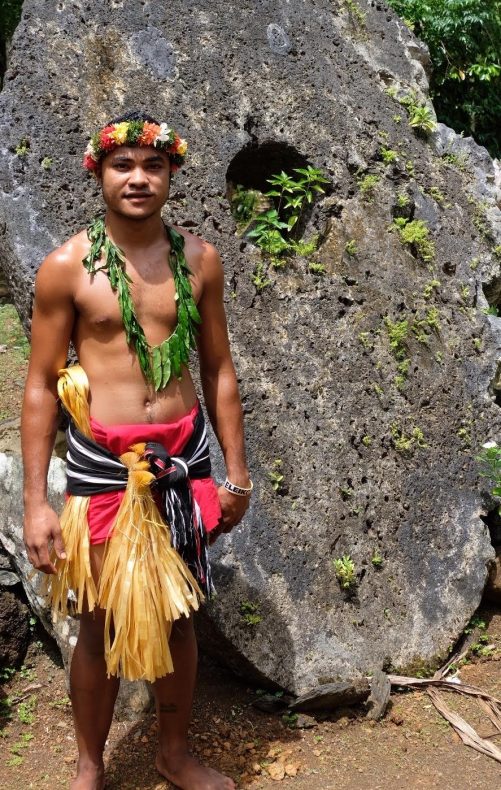
Photo by David Morris.
Yap’s leaders have made visits to China and reflect that Beijing has its own proud cultural traditions. With Beijing’s stated commitment to mutual respect and benefit, Yap’s leaders are hopeful China has potential to be more a partner than a pillager. China, flush with its own successful development in recent decades, is keen to support economic development in the region, with its vision of a “21st Century Maritime Silk Road” extending to the Pacific Islands, offering assistance with infrastructure and connectivity to drive sustainable development of trade, investment, and tourism in the region.
Nevertheless, the imbalance between China and tiny Pacific Islands might easily lead to culture clashes and misunderstandings. Indicative of this risk is the ongoing public relations challenge faced by a Chengdu-based company, Exhibition and Travel Group (ETG), which is interested in investing in Yap’s nascent tourism industry. A story took hold that ETG planned a 10,000 room resort to bring mass tourism to the tiny island of 7,000 residents and just 100 square kilometers. The story was a classic beat up, exaggerating the company’s plans. But even if the plans are for several hundred rooms, that is still a huge number of tourists for a small island.
Any project of a scale that brings charter flights from China is going to have a massive impact. People are polarized on the issue. Some say the need for economic development is so great that such changes must happen; others say the risks are too great a threat to what is unique about Yap. The usual China threat stories in international media led to the company keeping its head down in recent times. It’s a very Chinese approach: bide time, make investment plans, ignore all the bad media.
To be fair, ETG has an impressive track record in China. Its resorts are amongst the best in the global portfolio of the InterContinental Hotels Group (IHG). In Jiuzhaigou, in the foothills of one of China’s most spectacular national parks, ETG’s resort is built to a design that both complements the local environs and celebrates traditional culture. Its Chengdu hotels equally evoke traditional Sichuan design and every wall is adorned with original works by leading Chinese artists.
The company’s Yap-based representative, Yang Gang, who runs the charming old world Pacific Dive Resort, a rambling colonial style mansion that sits empty much of the year, says the planned new Yap resort can be tailored to a scale acceptable to the government and to meet the highest environmental standards. Yang says ETG’s intentions are to build an environmentally-friendly resort, train and employ the local community, and provide a platform for strengthening their traditional culture.
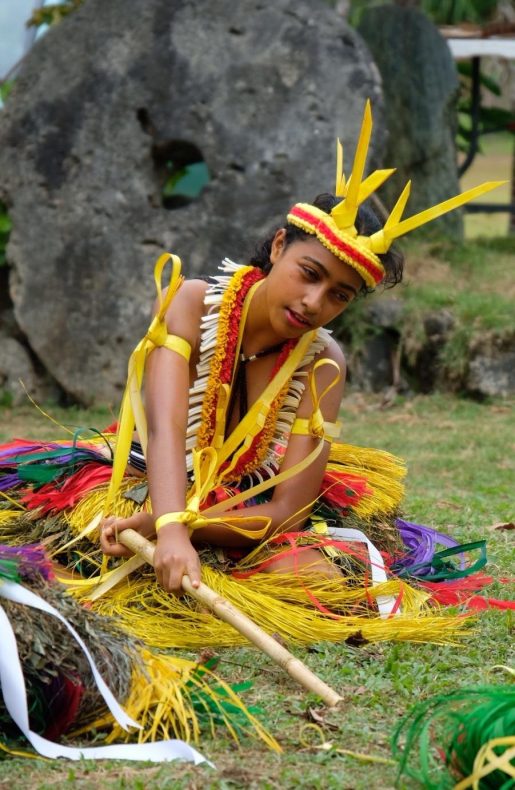
Photo by David Morris.
It is unclear if or when those plans might be put into effect, but it is clear that any such economic development project has the serious potential to bring real change.
Taking some time for the people of Yap to think through just what kind of tourism development they want might not be such a bad thing. The leaders also need a policy and guidelines on what kind of foreign investment is welcome, to ensure any tourism development is designed to meet Yap’s recently developed environmental regulations.
If Yap wants to economically develop, tourism is the obvious industry. But if it wants to preserve what is unique about Yap, leaders need to develop a plan for niche, boutique, ecotourism that could serve as guidance for the foreign investors who will be needed to make it happen. How Yap’s leaders interact with ETG and other interested international businesses with the means to assist development will set the pattern for the future. Yap needs the income and jobs; it also needs partners who will help to develop appropriate infrastructure.
Yap could be a unique, rejuvenating eco-escape for adventurous visitors to enjoy some amazing diving sites, dine on private beaches, sail in a traditional canoe, hike on ancient paths and learn about the rich history of Yap and the surrounding islands.
Yap is also home to a truly unique World Heritage site: the resting place of the the islanders’ ancient and giant stone money.
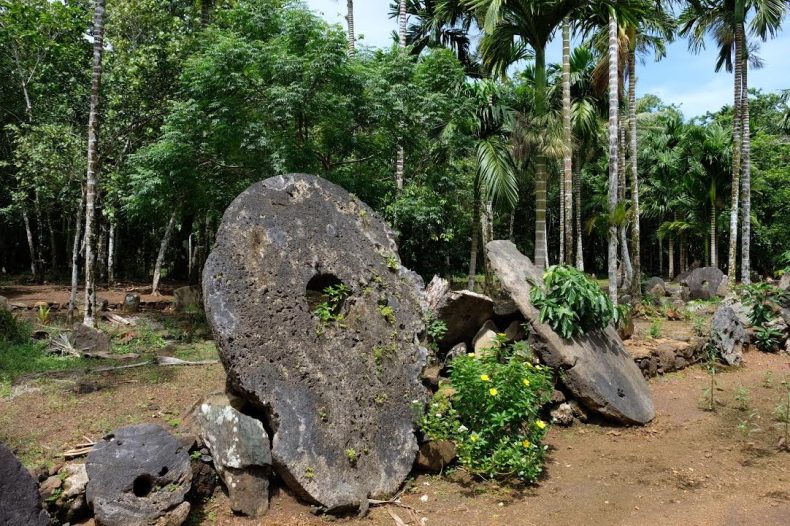
Photo by David Morris.
The giant coins — rings carved out of limestone, called rai — were brought by raft hundreds of miles across the sea from Palau as part of ritual exchanges of gifts between the two Micronesian peoples over centuries. The larger pieces were brought by modern ships as recently as the early years of the 20th century. The rai vary in size, with smaller pieces only 2 or 3 inches while the largest has a diameter of 12 feet and weighs nearly 8,800 pounds. Given the weight of the stone money, traded obligations were often made against the value of the money while the physical money itself stayed in the same location. — perhaps the ancient world’s precursor to an electronic funds transfer.
Yap’s cultural sites have not been preserved as well as they deserve. The foundations of traditional men’s and women’s houses and the house where young women would go to prepare for adulthood are overgrown but standing. The ancient paths are still there, as is the carefully constructed dock where canoes delivered the money. But these are sites that deserve interpretive signs and a management plan to preserve the assets. A carefully managed tourism industry could help fund preservation and celebrate the significance.
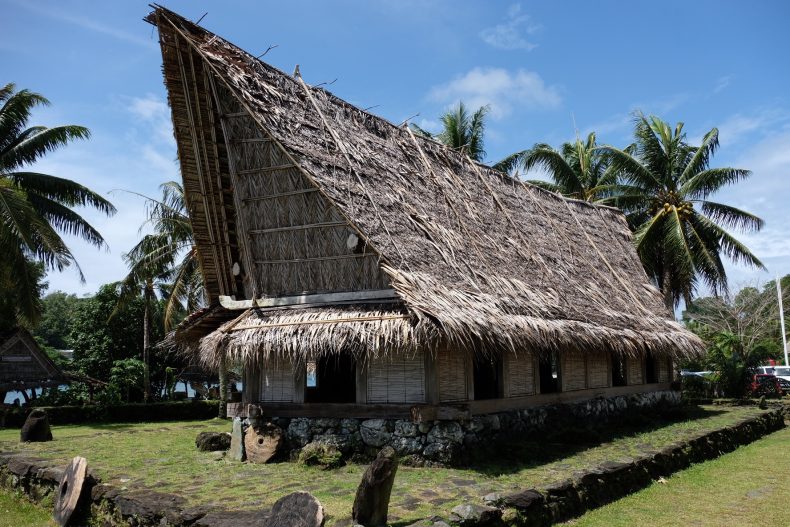
Photo by David Morris.
In the heart of Yap’s main town, Colonia, stand traditional meeting houses built without nails, but, again, a lack of visitors means there is little information to be found for the curious tourist. While the traditions of Yap have been passed down orally, it is not too difficult to imagine a future tourism industry that tells Yap’s stories in written form, in reviving traditional architecture and incorporating customary dances and other traditions, such as visitors carrying a twig, or a locally-woven basket.
Indeed, if done right a tourism industry could strengthen and maintain the island’s unique culture. The alternative, in which no viable path is found to economic self-sufficiency, is continued dependence on aid, licensing of foreign fishing boats, and a continued loss of young people to brighter futures overseas.
One of the international visitors this year for Yap Day, the annual cultural festival, was a young Chinese man eagerly observing and keen to learn about the island’s culture. He said he had traveled to many remote islands in search of pristine dive sites and had not been disappointed by the short dives he had done in Yap, despite the missing manta rays. He had enjoyed the whole experience and would recommend Yap to his independent traveler friends. There are plenty of culturally curious and environmentally aware tourists like that young man in China, and around the world, to supply Yap with income in the years ahead. These are not the much-feared package holiday groups attracted to famous and well-trampled destinations. For travelers like the young Chinese diver, the value of Yap depends on protecting its uniqueness and at least some of its innocence.
Can Yap have both development and preserve its traditions at the same time?
A wise elder put it all into perspective during my recent visit. Vincent Figir, one of the founders of FSM and former governor of Yap, said, “We have challenges but challenges can be met. It will all balance out, beggars cannot be choosers but in the end we determine the laws and we determine our own destiny.”
Indeed, Yap’s future is in the hands of its leaders and the plans they make for their people.
David Morris is the Pacific Islands Trade & Investment Commissioner in China, Chief Representative of the Pacific Islands Forum, and Adviser to UNESCAP’s Sustainable Business Network. He is a former diplomat, senior political adviser and founding Executive Director of the China Studies Center at the University of Sydney. You can follow him on twitter: @dm_aus













